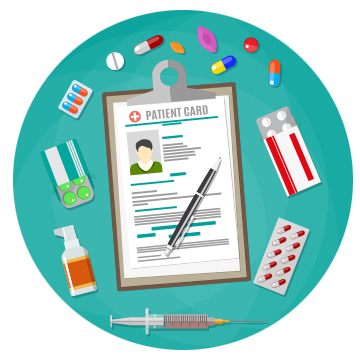Module 2: Basic Pharmacology of Controlled Drugs and Substances
Lesson 1
Opioids – Common adverse effects
Almost all patients will get some degree of constipation initially. Anticipate and reduce or prevent symptoms with increased fluid, dietary fiber and a stool softener or stimulant laxative for occasional symptomatic relief. Consider and treat causes of symptoms that could be related to other medications, or metabolic or pathophysiologic causes.
Nausea occurs in 50 – 70% of individuals taking opioids but is usually self-limited, lasting 1 to 2 weeks. Supine positioning post-dose may help minimize symptoms. An anti-emetic, as required, may be helpful for symptom management as well as a slower titration of the opioid dose. Common anti-emetics include dimenhydrinate, metoclopramide or scopolamine. Be sure the patient is aware of the potential sedating effects of both the opioid and the anti-emetic, and provide appropriate education.
Mild sedation may occur upon initiation of an opioid or with upward dose titration, lasting 7 to 14 days in most cases. Patients should be advised against driving or operating heavy machinery until their dose is stable or the degree of sedation is clear. Sedative effects of opioids can also cause respiratory depression, which can be a safety concern for both opioid naïve patients as well as those at risk for overdose.
Dysphoria, hallucinations and nightmares occur in a small percentage of patients. This occurs most commonly in the elderly or in other age groups when in the first few days of initiating upward titration is too rapid. Switching to a different opioid or a reduction of the dose may resolve these effects.
Pain is an antagonist of respiratory depression. Respiratory depression is usually only a problem if the starting dose is too high, the titration is too rapid, or the dosage increments too great, especially in patients with chronic lung disease, severe sleep apnea, renal failure, or gastroparesis. Naloxone is the treatment of choice.
Dry mouth is more common with potent opioids, tricyclics, anticonvulsants, and methadone. Meticulous oral hygiene, frequent oral fluids (water is preferred), and sugarless gum or candy to stimulate saliva should be recommended for this side effect.
Pruritus can occur due to opioid-induced histamine release. Symptoms can be managed with an anti-histamine, but it is important to counsel the patient about potential sedating effects. Some patients also report increased sweating, mostly with exertion and more commonly with higher doses of moderate to high potency opioids. Clonidine 0.1 mg twice daily is sometimes effective for relief of these symptoms, but caution is needed if a patient has low blood pressure because of the potential for orthostatic hypotension to occur. Peripheral edema can also occur due to vasodilation caused by either histamine release or antidiuretic hormone activity. Treatment can include short-term therapy with an antihistamine, a diuretic, or both together.
Allodynia (pain triggered by stimuli that do not normally trigger pain) and hyperalgesia (an increased sensitivity to painful stimuli) can worsen as the opioid dose increases. Initial treatment for this is dose reduction or a rotation to a different opioid. The generally accepted watchful dose that is recommended is less than 200 mg per day oral morphine equivalent.
Opioids may affect the hypothalamic-pituitary axis, resulting in changes in sex hormone levels in both men and women. Weight gain may also occur as a side effect of opioid therapy as well as comorbid health conditions, both of which need to be recognized and managed.
While rare, depressed mood can occur in patients taking opioids and does so most commonly in those with a history of depression. Initial management includes discontinuation of the opioid to see if mood symptoms improve and then recur when the opioid is restarted. An alternate opioid, a non-opioid analgesic, or the addition of venlafaxine or a tricyclic antidepressant may be considered. Caution with the addition of a tricyclic is necessary, due to side-effects.
Reflux can occur because of the relaxation effect of higher-dose opioids on lower esophageal sphincter function. Symptoms can be managed by decreasing the opioid dose or adding an anti-reflux therapy (e.g. H2 blocker or a proton pump inhibitor)
